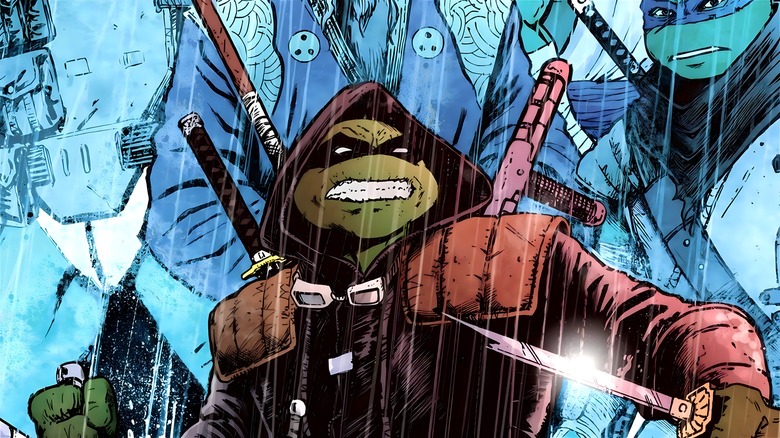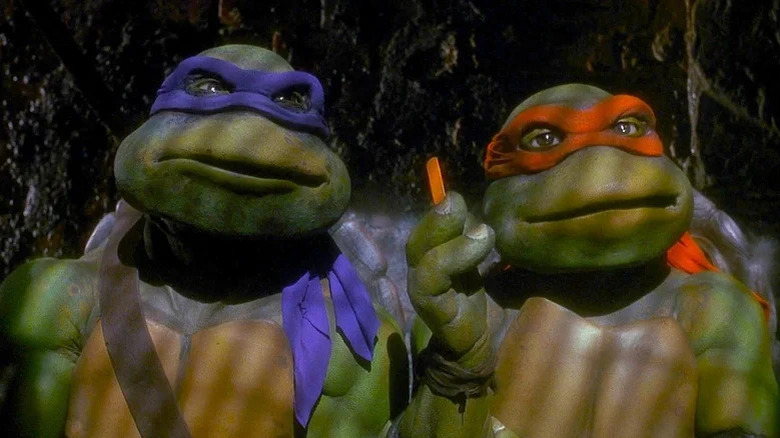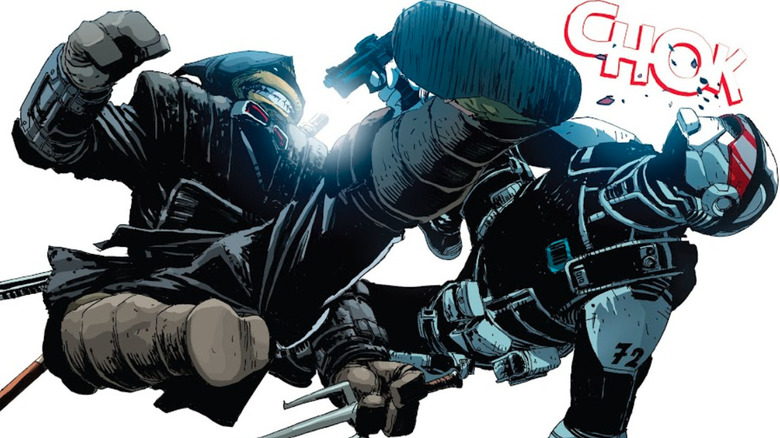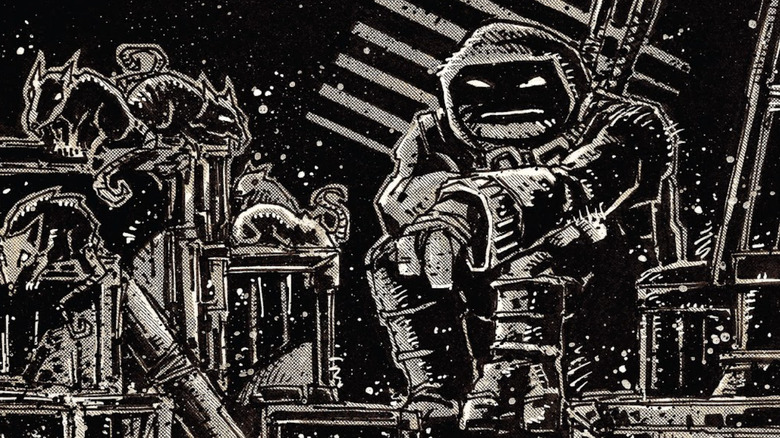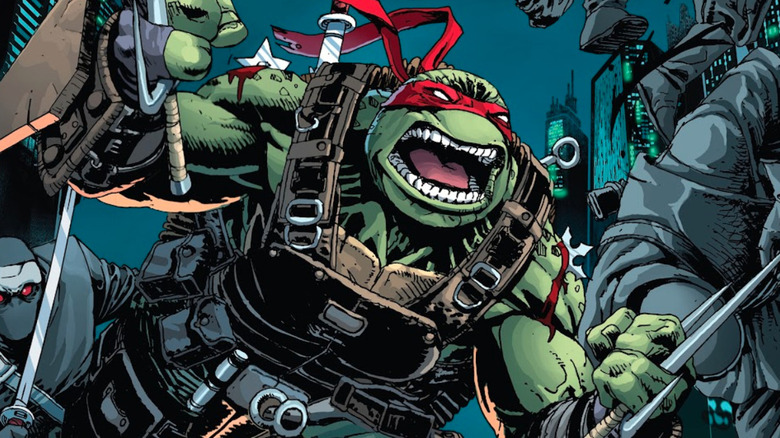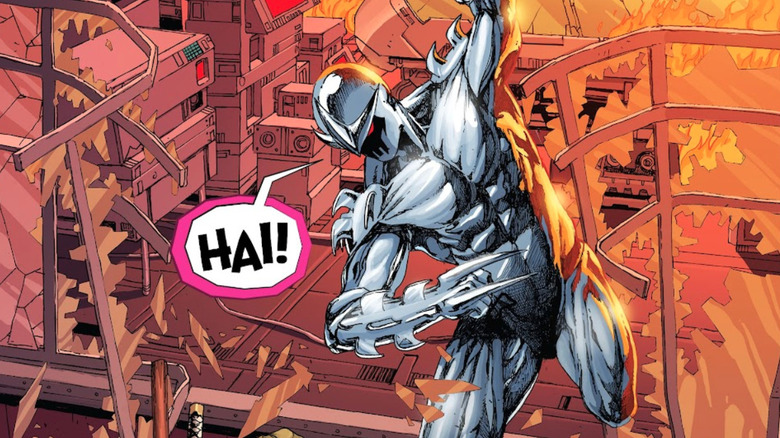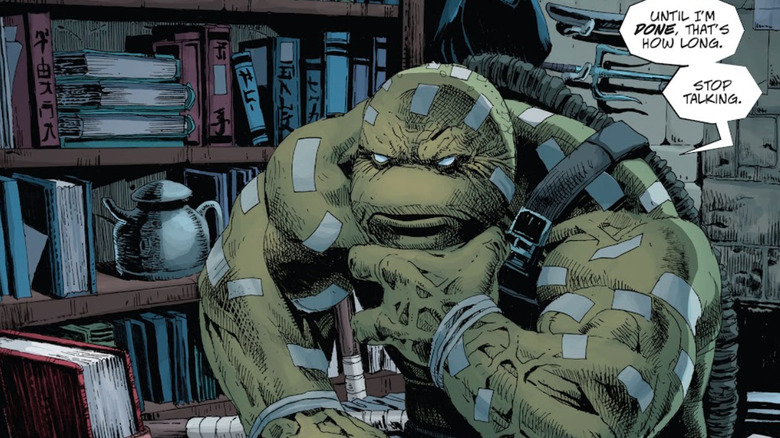TMNT: Mutant Mayhem Looks Fun, But The Last Ronin Is The Gritty Turtles Movie Fans Deserve
When Kevin Eastman and Peter Laird published their first black-and-white comic about a quartet of anthropomorphic Testudines in 1984, they could hardly guess what a monster the "Teenage Mutant Ninja Turtles" empire would become. Nearly four decades later — amid countless comics, six feature-length films, multiple TV series, and numerous action figures later — the franchise is once again kicking back into the pop culture zeitgeist with "Teenage Mutant Ninja Turtles: Mutant Mayhem." Seth Rogen's take on the titular turtles' time-tested tale takes a visually different approach to the versions we've seen so far, and judging by its marketing materials, it certainly kicks shells and takes names.
And yet...
No matter how high "Mutant Mayhem" will ultimately rank on the list of "Teenage Mutant Ninja Turtles" movies, it will nevertheless tell a variation of a story that's been told a hundred times across all conceivable media: The turtles, Master Splinter (Jackie Chan), and April O'Neil (Ayo Edebiri) fight a series of colorful villains, amid teenage concerns of "Do I fit in?" and a dash of interpersonal conflict. It's not a bad concept, of course — the franchise's sheer longevity proves that it works. Still, it would be nice to get a more radical (no pun intended) take on the "Teenage Mutant Ninja Turtles" lore one of these days, especially because there's a perfect comic that's just waiting for a movie adaptation.
That comic is 2020's "The Last Ronin," which tells a far more brutal and hopeless turtle story than anything fans are used to. If adapted, it could provide the franchise with its crowning cinematic achievement.
TMNT movies have been stagnant for decades
The "Teenage Mutant Ninja Turtles" franchise has certain built-in limits that make the stories it can tell a bit repetitive, especially in movie form. Over time, the franchise has constructed a series of tropes that every version of the story needs to hit, from the turtles' rough personality outlines to certain villains they have to face. As such, the movies we've seen so far tend to portray Leonardo as the leader, Raphael as a wild card, Donatello as a comparatively level-headed and smart gadgeteer, and Michelangelo as the relaxed, kid-friendly comic relief. They live in the New York City sewers, love pizza, have difficulty interacting with the outside world due to their appearance, and you just know that they'll face the Shredder at some point down the line ... usually multiple times per movie series.
The turtles aren't the only fictional heroes beholden to a stiff set of rules — just count the big beats every Batman movie hits regardless of who might be sitting in the director's seat. Still, at this point of the "TMNT" franchise's lengthy tenure, it's kind of disappointing that the only movie that's attempted to shake things up is "Teenage Mutant Ninja Turtles III" with its "Let's drop them in feudal Japan and see what happens" premise. It remains to be seen how much "Teenage Mutant Ninja Turtles: Mutant Mayhem" manages to address the issue, but since it once again tells the story of the titular heroes' first adventures out of the sewers, it may very well be that whatever shake-ups it attempts will be largely cosmetic.
"The Last Ronin," on the other hand ...
The Last Ronin is the rare truly original Teenage Mutant Ninja Turtles story
Fair warning: At this point, we're going to discuss the plot of "The Last Ronin" for a bit, so if you have it sitting on your bookshelf and you haven't found the time to read it yet, you might want to take a quick comic book break before continuing.
"The Last Ronin" has a very simple premise: The Foot Clan has won. All but one of the Teenage Mutant Ninja Turtles are dead, as are the vast majority of their allies. Long after the series of events that led to this tragedy, the world is ravaged by global warming and New York City is a walled high-tech dictatorship ruled by Shredder's brutal grandson, Oroku Hiroto. Suddenly, the last remaining turtle appears after decades of absence, brandishing his fallen brothers' weapons in a desperate attempt to rid the world of the Foot Clan once and for all. However, to complete his mission successfully, he also has to make peace with the past.
The story comes from original "Teenage Mutant Ninja Turtles" creators Kevin Eastman and Peter Laird — along with longtime series writer Tom Waltz — and can best be described as a combination of "Logan" and "John Wick," a truly wild combination in a "TMNT" setting. Apart from its copious action scenes, "The Last Ronin" benefits from being far darker and more psychological than your average turtle-themed tale, with a tone that's downright mournful at times. It's unlike anything "Teenage Mutant Ninja Turtles" fans have seen on the big screen yet, and with the right execution, it could easily become the best Turtle movie ever made.
The Last Ronin picks the exact right turtle to focus on
The true genius of "The Last Ronin" is that out of the four available characters, it picks the exact right one to focus on and plays its cards perfectly with that selection. The first issue of the comic portrays the last remaining member of the team as a hulking one-turtle army who wears a black mask and brandishes a host of different weaponry, which immediately makes you assume that it's either Leonardo or Raphael. But who would be surprised to find out that Leonardo, the committed leader, would stoically spend decades honing his fighting skills before embarking on a solo mission to take out the Foot Clan? What fan would be shocked to discover that the hot-headed Raphael returns to his last battle after years of absence, tearing through the opposition with ease?
Even Donatello would make sense as the last turtle standing because while the character tends to be more into engineering than physical combat, he's still a powerhouse in most adaptations. Michelangelo, however, is a genuine surprise. The character is nigh-invariably portrayed as a competent and talented fighter, but too unfocused and wise-cracking for people to take seriously. The revelation that he's the last turtle standing is not only a genuine wham moment but also gives the story an ultimate ace in the hole: The transformation of the empathetic, happy-go-lucky Mikey to a traumatized agent of vengeance allows for the most intriguing character study the franchise has ever given us. What's more, his advanced age also allows for a glimpse of just how powerful an adult mutant ninja turtle can be.
Every Ninja Turtle still gets plenty of attention in The Last Ronin
The fact that the story focuses so heavily on the sole surviving turtle might ruffle some fans' feathers but don't worry — Leonardo, Raphael, and Donatello remain very close to the story's center. Flashbacks are a crucial component of "The Last Ronin," and the story spends roughly as much time in the past as it does in its near-future present. Because of this, we get to spend quite a bit of time with all of the usual suspects as they fight their final battles.
In a way, the three fallen turtles are still present in the story's present timeline, as well. It's clear that the events he's gone through have traumatized Michelangelo quite deeply, and his ongoing issues manifest as ghostly visages of his three brothers who follow him around, offer tactical advice, and even criticize his actions on occasion. As such, while Mikey is still front and center for obvious reasons, the rest of the Teenage Mutant Ninja Turtles still get their share of the spotlight.
The villain game in The Last Ronin is on point
Though the "Teenage Mutant Ninja Turtles" movies tend to focus on the Shredder as the villain, the Turtles do have an extremely robust rogues gallery. "TMNT: Mutant Mayhem" features plenty of the more obscure villains, which is neat — but arguably not as neat as the approach "The Last Ronin" takes.
"The Last Ronin" keeps its villain game extremely streamlined. The main antagonist is dictator Oroku Hiroto, the Shredder's grandson who has a far more pragmatic approach to villainy, but whose sanity has clearly eroded over the years ... if it ever existed in the first place. Hiroto maintains an uneasy alliance with the franchise's resident mad scientist Baxter Stockman and has used his access to advanced technology to create an army of dangerous cyborgs.
Giving the protagonist a clear main antagonist and a horde of nameless mooks instead of a group of important villains is a great approach since it allows "The Last Ronin" the space to breathe and focus on world-building and Michelangelo's current situation. It doesn't hurt that Hiroto is quite a capable villain in his own right, bringing a perfect mixture of cunning cowardice and fearsome battle prowess into the mix.
The Last Ronin has already proved its worth as a story
Perhaps the greatest thing about potentially adapting "The Last Ronin" is that the story has already more than realized its potential. See, we're not the only ones praising its merits — in fact, "The Last Ronin" comic is a certifiable smash hit and even a New York Times Bestseller.
The industry has already noticed the potential of this gritty take on the "Teenage Mutant Ninja Turtles" lore. In 2023, Doug Rosen of Paramount Global announced that a "God of War"-style video game adaptation of "The Last Ronin" is in the works, which is a marked difference from the turtles' usual, comparatively lighthearted side-scrolling fare. Combined with the comic's success, a quality game could be more than enough to put the story on the map, so there's a decent chance that a movie adaptation might loom somewhere in the future, too.
There's no rush. For right now, Seth Rogen's version deserves its time on the sun. Once it's reboot time again, though, filmmakers would be wise to use to use "The Last Ronin" as their source material.
